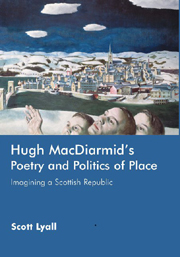Book contents
- Frontmatter
- Contents
- Dedication
- Acknowledgements
- Abbreviations of Works by Hugh MacDiarmid
- A Note on the Text
- Map
- Introduction: Imagining a Scottish Republic
- 1 ‘Towards a New Scotland’: Selfhood, History and the Scottish Renaissance
- 2 Debatable Land
- 3 ‘A Disgrace to the Community’
- 4 At the Edge of the World
- 5 ‘Ootward Boond Frae Scotland’: MacDiarmid, Modernism and the Masses
- Index
1 - ‘Towards a New Scotland’: Selfhood, History and the Scottish Renaissance
Published online by Cambridge University Press: 12 September 2012
- Frontmatter
- Contents
- Dedication
- Acknowledgements
- Abbreviations of Works by Hugh MacDiarmid
- A Note on the Text
- Map
- Introduction: Imagining a Scottish Republic
- 1 ‘Towards a New Scotland’: Selfhood, History and the Scottish Renaissance
- 2 Debatable Land
- 3 ‘A Disgrace to the Community’
- 4 At the Edge of the World
- 5 ‘Ootward Boond Frae Scotland’: MacDiarmid, Modernism and the Masses
- Index
Summary
Hugh MacDiarmid's writing career was a committed act of engagement and identification with the land of his birth, a poetics of place striving to reveal the essential totality of the nation:
So I have gathered unto myself
All the loose ends of Scotland,
And by naming them and accepting them,
Loving them and identifying myself with them,
Attempt to express the whole.
(‘Scotland’, CP1, 652)In A Drunk Man Looks at the Thistle he claims that ‘a' that's Scottish is in me’ (CP1, 145). The Drunk Man's self is compiled of ‘a composite diagram o' / Cross-sections o' my forbears' organs’ and although he attempts in self-disgust to exorcise this haunting by his ancestors he finds that ‘like bindweed through my clay it's run’ (CP1, 93). On examination of himself, the Drunk Man understands that his innermost spiritual identity is irredeemably connected to a metaphysical Scotland:
My ain soul looks me in the face, as 'twere,
And mair than my ain soul – my nation's soul!
(CP1, 93)In ‘Dìreadh I’ MacDiarmid names the nation as his Muse, ‘the very object of my song / – This marvellous land of Scotland’ (CP2, 1168), while ‘Conception’, one of a number of poems to paintings by fellow Borderer William Johnstone (1897–1981), gives birth to a new idea of Scotland that is at one with the poet's identity:
So that indeed I could not be myself
Without this strange, mysterious, awful finding
Of my people's very life within my own
– This terrible blinding discovery
Of Scotland in me, and I in Scotland
(CP2, 1070)- Type
- Chapter
- Information
- Hugh MacDiarmid's Poetry and Politics of PlaceImagining a Scottish Republic, pp. 23 - 55Publisher: Edinburgh University PressPrint publication year: 2006



